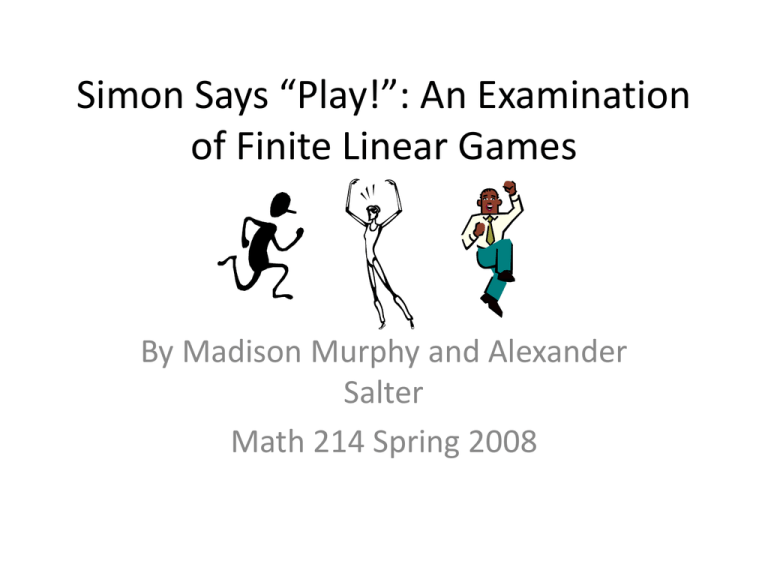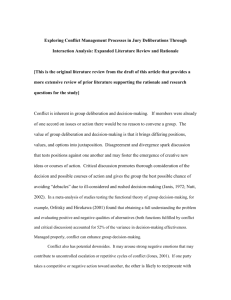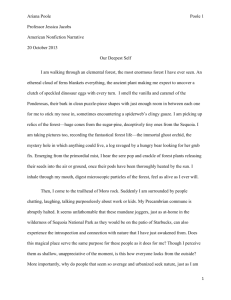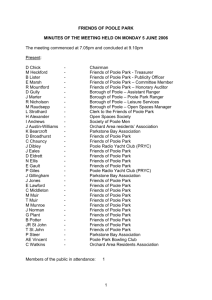Simon Says “Play!”: An Examination of Finite Linear Games
advertisement

Simon Says “Play!”: An Examination of Finite Linear Games By Madison Murphy and Alexander Salter Math 214 Spring 2008 Finite Linear Games What is a finite linear game??? A finite linear game is a problem that involves a situation where a physical system has only a finite number of states which can be altered by applying certain processes. Poole 109 Example: a group of light bulbs The light bulbs are the physical system with a finite number of states: on or off. These states are changed by flipping a switch. http://www.geocities.com/jaapsch/puzzles/light s.htm Playin’ with Numbers! When working with finite linear games, our number line is restricted to the number of states we have. For example, the light bulbs have only two states, on and off. So if we want to use numbers to represent those states, we can only use two of them, say 0 for ‘off’ and 1 for ‘on’. Z2 0 and Z3 1 0 2 Poole 110 1 Example 1 Five lights in a row! Parameters: Switches A-E control the lights. Turning on any light also turns on all adjacent lights. A B C Poole 109 D E Starting with all lights off, find a way to turn lights 1, 3, and 5 on. How??? Use command vectors! Assign vectors a-e to represent the resulting state when switches A-E are hit; ex: a=[1,1,0,0,0], b=[1,1,1,0,0]...e=[0,0,0,1,1] If constants v-z represent the number of times each switch is hit, then we have the linear equation va+wb+xc+yd+ze=s, where s is our desired outcome (lights 1, 3, and 5 on, 2, and 4 off, so s=[1,0,1,0,1]) Poole 110 Use an augmented coefficent matrix to determine if the desired outcome is possible. The matrix becomes: 11000|1 11100|0 01110|1 00111|0 00011|1 Poole 110 By row reducing the augmented coefficient matrix, we find that X5 is a free variable. 10001|0 X1 = X5 01001|1 X2 = 1 + X5 00100|1 X3 = 1 00011|1 X4= 1 + X5 00000|0 Remember, since we are in Z2,we only have two numbers in our domain: 0 and 1! So there are exactly two solutions (where X5 = 0 and X5= 1). Poole 111 Since X1 = X5 X2 = 1 + X5 X3 = 1 X4= 1 + X5 and X5 = 0 and X5 = 1 Substituting in gives the solution vectors [0,1,1,1,0] and [1,2,1,2,1] (however since we are in Z2, “2” becomes “0” so the solution vector is [1,0,1,0,1]). In other words, hitting switches B, C, and D, or switches A, C, and E (in any order) gives the desired outcome! Poole 111 Let’s check our answer By multiplying our matrix by the solution vectors we reach our target configuration of [1, 0, 1, 0, 1]. 11000 0 11100 1 = [1, 2, 3, 2, 1] convert to Z2! 0 1 1 1 0 * 1 so the vector =[ 1, 0, 1, 0, 1] 00111 1 This checks out for the 2nd 00011 0 solution vector as well. Poole 110 Simon Says “Play!” Our game: We have five “math dolls” which can be ordered to jog in place or jump in place (starting at rest). So we have three states represented by numbers “0” for rest, “1” for jogging, and “2” for jumping. Dolls must progress through the states in order, and the same rules from before apply. IMPORTANT: Since we have three states, we’re in Z3 now! Poole 110 Math Dolls! 1 2 3 4 5 What will the command vectors be for our math dolls? Answer: the same vectors from the previous problem. Can you explain why? Example: Ordering math doll 1 to start jogging would result in the vector [1,1,0,0,0]. After this, ordering doll 3 to start jogging would result in the vector [1,2,1,1,0]. Remember, we’re in Z3 now! Poole 110 If we want a desired outcome for our math dolls, represented by the vector [t1, t2, t3, t4, t5], our augmented coefficient matrix becomes: 1 1 0 0 0 | t1 1 1 1 0 0 | t2 0 1 1 1 0 | t3 0 0 1 1 1 | t4 0 0 0 1 1 | t5 Row reducing this matrix will reveal if the desired outcome is possible and if so what orders need to be given to create this outcome. Poole 110 Jogging Math Dolls Let’s say we want all the math dolls to be jogging. Then our desired outcome will be [1,1,1,1,1]. Plug this vector into our augmented coefficient matrix to find our solution vectors. We get three: [1,0,0,1,0], [0,1,0,0,1], and [-1,2,0,-1,2]. Hey…you can’t hit a switch ‘negative one’ times! CONVERT TO Z3: [-1,2,0,-1,2] becomes [2,2,0,2,2] because of the repeating nature of the numbers! Poole 110 So what do these solution vectors mean? Take [1,0,0,1,0]. This means that if we tell math dolls 1 and 4 to jog (regardless of order), we’ll get our desired outcome of all the dolls jogging represented by [1,1,1,1,1]. 1 2 3 Poole 110 4 5 Not every desired outcome is possible with our game. We tried to find a way to have math dolls 1 through 4 jumping while math doll 5 jogged, represented by the vector: [2, 2, 2, 2, 1]. Our row reduced augmented coefficient matrix is: 1 1 0 0 0| 0 0 0 1 0 0| 0 0 0 0 1 0| 0 0 0 0 0 1| 0 0 0 0 0 0|-1 Since we have a row of zeros equaling -1 this desired outcome is unattainable. Poole 110 Thanks for listening! Poole 110 Sources Poole, David. Linear Algebra, A Modern Introduction (Second Edition). Belmont: Thompson Higher Education, 2006. Scherhuis, Jaap. "Lights Out." Jaap's Puzzle Page. 28 March. 2008 http://www.geocities.com/jaapsch/puzzles/lig hts.htm Poole 110











